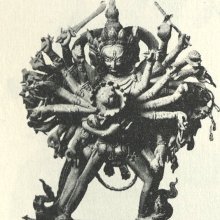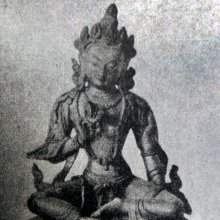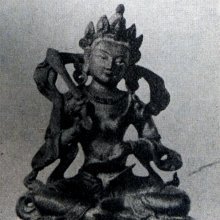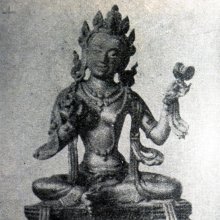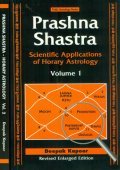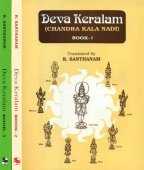Dhanu, Dhanū: 24 definitions
Introduction:
Dhanu means something in Buddhism, Pali, Hinduism, Sanskrit, Jainism, Prakrit, Marathi, Hindi, biology. If you want to know the exact meaning, history, etymology or English translation of this term then check out the descriptions on this page. Add your comment or reference to a book if you want to contribute to this summary article.
Images (photo gallery)
(+1 more images available)
In Hinduism
Purana and Itihasa (epic history)
Source: Cologne Digital Sanskrit Dictionaries: The Purana Index1a) Dhanu (धनु).—A son of Sṛnjaya, brother of Vasudeva.*
- * Brahmāṇḍa-purāṇa III. 71. 193.
1b) A son of Śamīka.*
- * Matsya-purāṇa 46. 27.
1c) A pole from the term dhanurdaṇḍa, 96 angulas in measurement. Two of them measure one nāli, and 8000 one yojana.*
- * Brahmāṇḍa-purāṇa I. 7. 96, 100; IV. 2. 124-6; Vāyu-purāṇa 101. 124.

The Purana (पुराण, purāṇas) refers to Sanskrit literature preserving ancient India’s vast cultural history, including historical legends, religious ceremonies, various arts and sciences. The eighteen mahapuranas total over 400,000 shlokas (metrical couplets) and date to at least several centuries BCE.
Jyotisha (astronomy and astrology)
Source: Wikibooks (hi): Sanskrit Technical TermsDhanu (धनु).—Arc. Note: Dhanu is a Sanskrit technical term used in ancient Indian sciences such as Astronomy, Mathematics and Geometry.

Jyotisha (ज्योतिष, jyotiṣa or jyotish) refers to ‘astronomy’ or “Vedic astrology” and represents the fifth of the six Vedangas (additional sciences to be studied along with the Vedas). Jyotisha concerns itself with the study and prediction of the movements of celestial bodies, in order to calculate the auspicious time for rituals and ceremonies.
Ayurveda (science of life)
Source: Ancient Science of Life: Snake bite treatment in Prayoga samuccayamDhanu (धनु) refers to the month corresponding to December-January, during which time snakes are born with “strong and energetic” characteristics, according to the 20th century Prayogasamuccaya (one of the most popular and widely practised book in toxicology in Malayalam).—According to the month in which they hatch, their characters differ. In that, the snakes born in caitra month (March- April) will have evil habits, those in dhanu (Dec- Jan) month will be strong and energetic, the ones in makara (Jan- Feb) month will be more poisonous than others. Snakes open their eyes on the 7th day after hatching and take further five days more to gain consciousness and to teeth. In another 30 days, they become poisonous.

Āyurveda (आयुर्वेद, ayurveda) is a branch of Indian science dealing with medicine, herbalism, taxology, anatomy, surgery, alchemy and related topics. Traditional practice of Āyurveda in ancient India dates back to at least the first millenium BC. Literature is commonly written in Sanskrit using various poetic metres.
General definition (in Hinduism)
Source: Wisdom Library: HinduismDhanu; ancient Hindu unit of measurement of distance. 4 Hastas make 1 Dhanu, and 8000 Dhanus make up for a single Yojana.
If we consider a single Yojana to be 8 miles (~12.87km), one Dhanu would correspond to roughly 5.28 feet (~1.61m)
If we consider a single Yojana to be 5 miles (~8.04km), one Dhanu would correspond to roughly 3.31 feet (~1.01m)
Another conversion: 300 Dhanus is one Nalva.
Source: archive.org: Vedic index of Names and SubjectsDhanu (धनु, ‘sandbank’) (fem.) occurs several times in the Rigveda, but only metaphorically of the clouds in the atmosphere. Dhanū is found in the Atharvaveda, where it seems to denote a sandbag used to prevent bleeding.
In Buddhism
Tibetan Buddhism (Vajrayana or tantric Buddhism)
Source: OSU Press: Cakrasamvara SamadhiDhanu (धनु) refers to a “bow”, according to the Guru-maṇḍala-arcana [i.e., “Guru Mandala Worship]” ritual often performed in combination with the Cakrasaṃvara Samādhi, which refers to the primary pūjā and sādhanā practice of Newah Mahāyāna-Vajrayāna Buddhists in Nepal.—Accordingly, “By the form of a skull cup, and by the letter Māṃ, Vāruṇī, Eighteen arms, one face, red color, and three eyes, A sword, arrow and hook, on the right, a skull cup, ax and banner, Thus a mace, thus a bell, and in the ninth, granting wishes, A two-headed drum, a bow (dhanu) and noose, a staff and a water pot, A trident, hammer and lute, and thus a number, in the upper hand, A young adolescent beauty, a great beauty, a beautiful goddess”.

Tibetan Buddhism includes schools such as Nyingma, Kadampa, Kagyu and Gelug. Their primary canon of literature is divided in two broad categories: The Kangyur, which consists of Buddha’s words, and the Tengyur, which includes commentaries from various sources. Esotericism and tantra techniques (vajrayāna) are collected indepently.
In Jainism
General definition (in Jainism)
Source: Wisdom Library: JainismDhanu (धनु).— The dhanus are a group of celestial beings living in the lower regions of adholoka (lower world) according to Jaina cosmology. Adholoka is made up of seven regions and offers residence to the infernal beings existing within these lands.
Source: academia.edu: Tessitori Collection IDhanu (धनु) refers to one of the fifteen Paramādhārmīs causing suffering in the hells (naraka), according to Rājasoma’s “Naraka ko coḍhālyo”, which is included in the collection of manuscripts at the ‘Vincenzo Joppi’ library, collected by Luigi Pio Tessitori during his visit to Rajasthan between 1914 and 1919.—No name of any source is given in the text but the three stages followed in the exposition correspond closely to those found in a handbook such as Nemicandrasūri’s Pravacanasāroddhāra, [e.g.,] 3) sufferings inflicted by the fifteen Paramādhārmīs [e.g., Dhanu]. [...] These gods (here Sūra or Deva) form a sub-class of the Asurakumāras and perform their tasks in the first, second and third hells.

Jainism is an Indian religion of Dharma whose doctrine revolves around harmlessness (ahimsa) towards every living being. The two major branches (Digambara and Svetambara) of Jainism stimulate self-control (or, shramana, ‘self-reliance’) and spiritual development through a path of peace for the soul to progess to the ultimate goal.
Biology (plants and animals)
Source: Google Books: CRC World Dictionary (Regional names)Dhanu in India is the name of a plant defined with Buchanania lanzan in various botanical sources. This page contains potential references in Ayurveda, modern medicine, and other folk traditions or local practices It has the synonym Buchanania latifolia Roxb..
Example references for further research on medicinal uses or toxicity (see latin names for full list):
· Journal of Tree Sciences (1984)
· J. Sci. Food Agric. (1977)
· Quarterly Journal of the Mythic Society (1963)
· Hortus Bengalensis, or ‘a Catalogue of the Plants Growing in the Hounourable East India Company's Botanical Garden at Calcutta’ (1814)
· Journal of Cytology and Genetics (1990)
· Journal of Ethnopharmacology (2000)
If you are looking for specific details regarding Dhanu, for example side effects, diet and recipes, extract dosage, pregnancy safety, health benefits, chemical composition, have a look at these references.

This sections includes definitions from the five kingdoms of living things: Animals, Plants, Fungi, Protists and Monera. It will include both the official binomial nomenclature (scientific names usually in Latin) as well as regional spellings and variants.
Languages of India and abroad
Pali-English dictionary
Source: Sutta: The Pali Text Society's Pali-English DictionaryDhanu, (nt.) (Sk. dhanus, to Ohg. tanna fir-tree, also oak, orig tree in general, cp. dāru) a bow M.I, 429; J.I, 50, 150; II, 88; IV, 327; PvA.285.

Pali is the language of the Tipiṭaka, which is the sacred canon of Theravāda Buddhism and contains much of the Buddha’s speech. Closeley related to Sanskrit, both languages are used interchangeably between religions.
Marathi-English dictionary
Source: DDSA: The Molesworth Marathi and English Dictionarydhanu (धनु).—m (S) A bow. 2 The sign Sagittarius. 3 The bow for cleaning cotton. 4 A segment of a circle, an arc.
Source: DDSA: The Aryabhusan school dictionary, Marathi-Englishdhanu (धनु).—m A bow. f The sign Sagittarius. An arc.
Marathi is an Indo-European language having over 70 million native speakers people in (predominantly) Maharashtra India. Marathi, like many other Indo-Aryan languages, evolved from early forms of Prakrit, which itself is a subset of Sanskrit, one of the most ancient languages of the world.
Sanskrit dictionary
Source: DDSA: The practical Sanskrit-English dictionaryDhanu (धनु).—
1) A bow (perhaps for dhanus q. v.).
2) Name of the प्रियङ्गु (priyaṅgu) tree.
3) A measure of four hastas.
4) The sign Sagittarius of the zodiac.
5) An archer. -f. A sandy shore.
Derivable forms: dhanuḥ (धनुः).
--- OR ---
Dhanū (धनू).—f. A bow. -m. A store of grain.
Source: Cologne Digital Sanskrit Dictionaries: Shabda-Sagara Sanskrit-English DictionaryDhanu (धनु).—m.
(-nuḥ) 1. A bow. 2. The sign Sagittarius. 3. A tree: see piyāla. 4. A measure of four cubits. E. dhana here meaning to cast as an arrow, Unadi affix un also dhanus.
--- OR ---
Dhanū (धनू).—m.
(-nūḥ) A bow: see the last.
Source: Cologne Digital Sanskrit Dictionaries: Benfey Sanskrit-English DictionaryDhanu (धनु).— (a curtailed form of dhanus), m. 1. A bow, [Hitopadeśa] pr. [distich] 22. 2. A measure of length, Mahābhārata 8, 4224.
Source: Cologne Digital Sanskrit Dictionaries: Cappeller Sanskrit-English DictionaryDhanu (धनु).—1. [masculine] bow.
--- OR ---
Dhanu (धनु).—2. & dhanū [feminine] sandbank, sandy shore, island ([figuratively] of a cloud).
Source: Cologne Digital Sanskrit Dictionaries: Monier-Williams Sanskrit-English Dictionary1) Dhanū (धनू):—[from dhan] 1. dhanū m. a store of grain, [cf. Lexicographers, esp. such as amarasiṃha, halāyudha, hemacandra, etc.] (for 2. See dhanu).
2) Dhanu (धनु):—m. or ([Uṇādi-sūtra i, 82]) 2. dhanū f. ([from] √2. dhan?) a bow, [Hitopadeśa; Śāntiśataka]
3) a measure of 4 Hastas or cubits, [cf. Lexicographers, esp. such as amarasiṃha, halāyudha, hemacandra, etc.] (cf. dhanv-antara below)
4) the sign of the zodiac Sagittarius, [Priyadarśikā i, 5]
5) Buchanania Latifolia, [cf. Lexicographers, esp. such as amarasiṃha, halāyudha, hemacandra, etc.]
6) Semecarpus Anacardium, [cf. Lexicographers, esp. such as amarasiṃha, halāyudha, hemacandra, etc.]
7) [according to] to some also, ‘water, juice etc.’; cf. √dhanv, dhanutṛ.
8) f. (dhanu, or dhanū) a dry sandbank, a sandy shore (cf. [English] bight, [German] Bucht), [Ṛg-veda; Atharva-veda i, 17] ([nominative case] nūs).
Source: Cologne Digital Sanskrit Dictionaries: Yates Sanskrit-English Dictionary1) Dhanu (धनु):—(nuḥ) 2. m. A bow; Sagittarius; measure of four cubits; a tree.
2) Dhanū (धनू):—(nūḥ) 2. m. Idem.
[Sanskrit to German]
Sanskrit, also spelled संस्कृतम् (saṃskṛtam), is an ancient language of India commonly seen as the grandmother of the Indo-European language family (even English!). Closely allied with Prakrit and Pali, Sanskrit is more exhaustive in both grammar and terms and has the most extensive collection of literature in the world, greatly surpassing its sister-languages Greek and Latin.
Hindi dictionary
Source: DDSA: A practical Hindi-English dictionaryDhanu (धनु):—(nf) a bow.
...
Prakrit-English dictionary
Source: DDSA: Paia-sadda-mahannavo; a comprehensive Prakrit Hindi dictionary1) Dhaṇu (धणु) in the Prakrit language is related to the Sanskrit word: Dhanuṣ.
2) Dhaṇu (धणु) also relates to the Sanskrit word: Dhanus.
Prakrit is an ancient language closely associated with both Pali and Sanskrit. Jain literature is often composed in this language or sub-dialects, such as the Agamas and their commentaries which are written in Ardhamagadhi and Maharashtri Prakrit. The earliest extant texts can be dated to as early as the 4th century BCE although core portions might be older.
Kannada-English dictionary
Source: Alar: Kannada-English corpusDhaṇu (ಧಣು):—[noun] a term used in praising, commending (another).
--- OR ---
Dhaṇu (ಧಣು):—[noun] = ಧಣುವಟ್ಟ [dhanuvatta].
--- OR ---
Dhanu (ಧನು):—
1) [noun] a flexible strip of wood or metal, with both ends tied tightly with a chord, used to shoot arrows from; a bow.
2) [noun] a linear measure of four cubits.
3) [noun] (astrol.) the ninth sign of the zodiac entered by the sun about November 21; Sagittarius.
4) [noun] a large Southern constellation in the brightest part of the Milky way, beyond which lies the centre of our galaxy; the archer constellation; Sagittarius.
Kannada is a Dravidian language (as opposed to the Indo-European language family) mainly spoken in the southwestern region of India.
Nepali dictionary
Source: unoes: Nepali-English DictionaryDhanu (धनु):—n. 1. bow; 2. a kind of pallet-bow; 3. Astrol. Sagittarius; 4. a bow-like cotton processing instrument;
Nepali is the primary language of the Nepalese people counting almost 20 million native speakers. The country of Nepal is situated in the Himalaya mountain range to the north of India.
See also (Relevant definitions)
Partial matches: U, Dhana, Tana.
Starts with (+17): Dhanuabhedam, Dhanudhari, Dhanudurga, Dhanuggaha, Dhanuggaha Sutta, Dhanuggaha Tissa, Dhanugriha, Dhanugupta, Dhanuh, Dhanuhasta, Dhanuhkanda, Dhanuhkhanda, Dhanuhpata, Dhanuhsamstha, Dhanuhshakha, Dhanuhshala, Dhanuhshata, Dhanuhshrama, Dhanuhshreni, Dhanukalapa.
Query error!
Full-text (+417): Dhanus, Dhanushpani, Dhanuhshakha, Dhanurdhara, Dhanuhshreni, Tanu, Dhanuhstambha, Dhanurvidya, Dhanuhasta, Dhanurguna, Dhanuhpata, Dhanuhkhanda, Dhanushpata, Dhanurlata, Dhanuhshala, Dhanurveda, Dhanuhkanda, Dhanurbhrit, Dhanurgraha, Dhanurasana.
Relevant text
Search found 133 books and stories containing Dhanu, Dhana-u, Dhanū, Dhaṇu; (plurals include: Dhanus, us, Dhanūs, Dhaṇus). You can also click to the full overview containing English textual excerpts. Below are direct links for the most relevant articles:
Garga Samhita (English) (by Danavir Goswami)
Verse 6.10.6 < [Chapter 10 - In the Description of the Gomatī River, the Glories of Cakra-tīrtha]
Verse 6.19.16 < [Chapter 19 - In the First Fortress of Dvārakā, the Glories of Līlā-sarovara, etc.]
Verse 1.7.52 < [Chapter 7 - Description of the Conquest of All Directions]
Chaitanya Bhagavata (by Bhumipati Dāsa)
Verse 1.9.195 < [Chapter 9 - Nityānanda’s Childhood Pastimes and Travels to Holy Places]
Verse 2.28.9 < [Chapter 28 - The Lord’s Pastime of Accepting Sannyāsa]
Verse 1.9.47 < [Chapter 9 - Nityānanda’s Childhood Pastimes and Travels to Holy Places]
Surgery in ancient India (Study) (by P. P. Prathapan)
5. Dhanvantari and the Indian medical system < [Chapter 3 - Schools of Surgery in ancient India]
Rig Veda (translation and commentary) (by H. H. Wilson)
Skanda Purana (by G. V. Tagare)
Chapter 2 - Brahmakuṇḍa and Sahasradhārā < [Section 8 - Ayodhyā-māhātmya]
Chapter 227 - Special Injunctions regarding the Pilgrimage < [Section 3 - Revā-khaṇḍa]
Chapter 332 - Greatness of Rukmiṇī < [Section 1 - Prabhāsa-kṣetra-māhātmya]
Vishnu Purana (by Horace Hayman Wilson)
Related products

